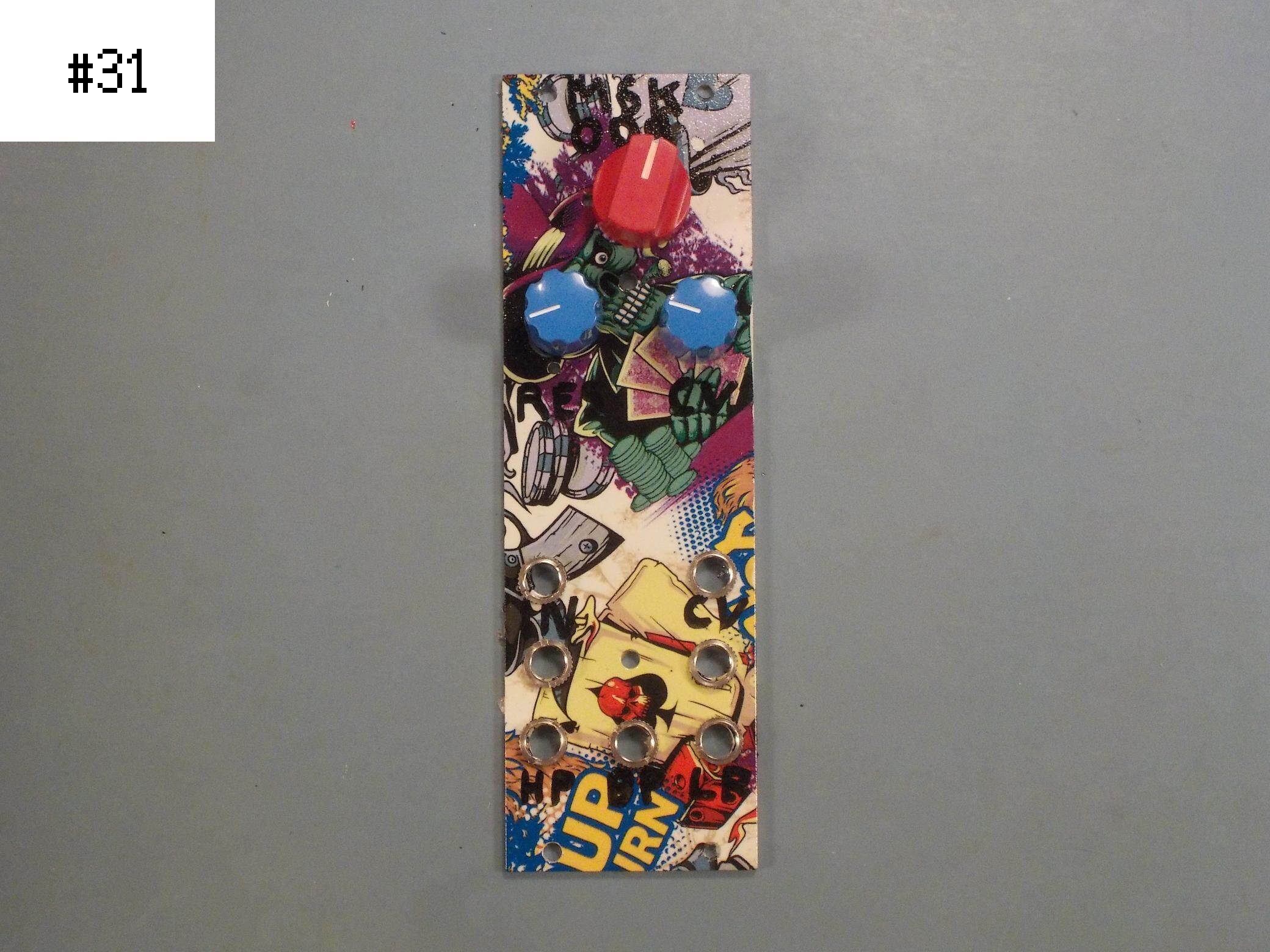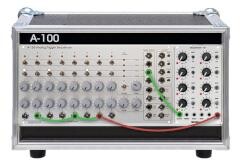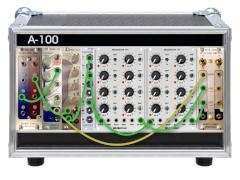Modular Synthesis Intro, part 12: Sequencing
2018-04-30 intro
This is Part 12 of a series that started with Part 1.
Many beginners say they're interested in making "drones" with their modular synths - musical textures that eschew conventional musical notions like rhythm and melody. I think part of the appeal is the (not entirely correct) perception that drones are easy and don't require musical ability. It's also a fact of life that if you have very few modules it's a lot easier to make drones than anything else. Drones are fine, and I make a module especially adapted to them, but if you want to take the next step and make music with notes in it, you need something to trigger and control the notes, and that often means a sequencer.
Eurorack modulars are usually controlled by two voltages: one for pitch (on the V/octave plan) and one "gate" voltage which goes high (typically 5V) during the note and low (0V) for the silences in between. Some other modular systems also use separate "triggers"; the note is started by a short pulse on the trigger voltage and then remains playing as long as the gate voltage is high. In Eurorack there is no clear distinction between a trigger and a gate, but we still refer to voltages as triggers if they are meant to activate things like drum sounds that control their own duration.
To play notes on the synth, then, you need something to generate the pitch and gate voltages, and that comes down to one of two things. You can use a controller to manually create the notes, whether it is a keyboard, ribbon controller, theremin antenna, or something else; or you can use some method of generating notes automatically, usually according to some pre-determined plan. That is the realm of the sequencer.
Classic step sequencers
The most traditional kind of sequencer for modular synthesizers looks something like this Doepfer A-155 (US$375).
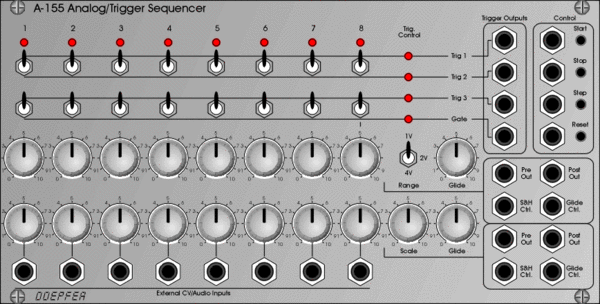
This is what's usually called a step sequencer (though that can also refer to more complicated types), or sometimes (but incorrectly) an "analog" sequencer. Note the row of LEDs along the top. The module's operation is very simple: it has eight steps and on every beat, it goes to the next step, so it's repeating a cycle of eight steps. There are two rows each of knobs and switches, allowing you to set a couple of control voltages and some digital outputs for each step. You can set up a repeating eight-note melody with these.
The good thing about this kind of sequencer is its versatility. It's a very modular way to do sequencing - breaking the task down into the simplest possible operations and then allowing you to build up more complexity by adding modules. The down-side is that it has a very strong tendency to push the music to consist solely of repeating loops. If you're making EDM, fine; if you're making something else, it may not be the emphasis you want.
Arguably even simpler are trigger sequencers, which despite the name often do gates as well, but not variable control voltages suitable for pitches. These are handy for drum rhythms. They're often packaged in small modules that don't take up much space, and are controlled with a push-button menu interface. A typical example is the Intellijel µStep (US$195), which fits in just 4HP.
Combining sequences
If you're not making a style of music based on repeated, unchanging loops, then you may want to generate changing, or at least longer, sequences under modular control. Even very simple sequencers can work well for that, especially if you have more than one of them. You don't necessarily need a fancier computerized sequencer.
The A-155 has a row of inputs along the bottom allowing each step to take a control voltage; when the sequencer hits a step with something plugged into the corresponding input, the sequencer's output for the lower row will be the input plugged into that step, attenuated by the lower-row knob for the step. Thus, it'll be a repeating pattern except that some of the steps change each time around the loop, according to the external voltages. A typical way to make use of this is by adding a second sequencer, clocked at a lower rate, to set the values for the changing steps. Here's a typical patch.
For clarity I've omitted the connections that would be needed to provide some kind of clock input and make use of the output; the focus here is just on the sequencers. I've shown an EMW Sequencer 101 as a typical example of a basic CV sequencer. The output from that is driving the inputs for three of the eight A-155 steps; but one of the trigger outputs of the A-155 is also being used to clock the EMW. Output to the oscillators, filters, and so on is taken from the A-155's output. So the A-155 runs through its sequence, producing output just from its own knobs on beats 1, 3, 4, 6, and 8. Those notes are the same in each eight-beat loop. But on beats 2, 5, and 7, it feeds through the output from the EMW. Those notes are different on different loops. And the EMW (as indicated by the little white circles I added to the picture) advances to new notes on the A-155's beats 1, 5, and 6. After going through one eight-beat loop, the EMW will have advanced only three notes, so in the next loop, it will generate different notes. In order for the whole patch to repeat, both sequencers must not only return to their starting points but do so at the same time, which takes a total of 64 beats. It's easy to build up sophisticated patterns this way.
Another way to combine two or more sequencers is to add and subtract their control voltages. If one sequencer gives an output stepping through the values +1V, +2V, +1.5V, +3V, and another goes 0V, 0V, +1V, -1V, then their sum looks like +1V, +2V, +2.5V, +2V. With two sequences of differing length, they slide against each other and produce an ever-changing sequence whose length is the least common multiple of the two. If they have no common factors, that can be as much as the two lengths multiplied together.
Adding the voltages is a powerful technique but can be a little hard to control. One problem with it is that unless you're careful, the result may not sound very musical; control voltages corresponding to notes in a traditional musical scale (like "D minor") often will not be in such a scale after being added together. You can reduce that effect by tightly controlling one of the two sequences - for instance, if one of the two sequences is in a musical scale and the other consists only of octave and perfect-fifth shifts, the result will still sound a lot like a traditional musical scale. It also helps to drive one of the sequences from a much slower clock than the other, so that the result will sound like modulation (in the musical sense of changing key) rather than just scrambling the melody. A more extreme thing to do is to run the summed voltages through a quantizer to force them into your chosen musical scale.
If you don't care about accuracy in the voltage addition, then you can add the sequence voltages with any typical "utility" mixer. The North Coast Synthesis MSK 011 Transistor Mixer is fine for that. If you also don't need to adjust the levels, you can use what's called a "unity" mixer, like Intellijel's version. These have the advantage of being cheaper because they don't have control knobs and therefore potentiometers (some of the most costly parts in module construction). However, none of these mixers are highly accurate. Building a circuit whose output voltage is exactly the sum of the input voltages, isn't an entirely trivial proposition. Every component in an electronic device is subject to engineering tolerances, and when a summing mixer is built with standard-tolerance components, it's quite common that the output voltage may be only within a few percent of the desired sum, not exactly on it. So these mixers are appropriate when you adjust your sequencer notes "by ear" without aiming for precise concert pitch, but if you need accurate tuning, then you need a unity mixer specifically designed to maintain tuning accuracy. These are often called "precision adders." North Coast Synthesis makes one with some extra features especially for combining sequencer outputs: the MSK 008 Dual VC Octave Switch. It's built with closer-tolerance components than are used in basic non-precision unity mixers, and calibrated after construction to compensate for any remaining inaccuracy. Here's a typical patch using it, along with some other North Coast modules, to generate a complex evolving sequence from basic knob sequencers.
The Fixed Sine Bank at left drives all the timing. One of its slower outputs goes through a Transistor Mixer, acting as attenuator, to the QUA input on the Octave Switch. That controls octave shifts, up and down up to two octaves. The attenuation from the Transistor Mixer is needed because the Fixed Sine Bank's direct output covers +-5V, meaning that if not attenuated, the octave shifting would usually be at the maximum in one direction or the other. The lower voltage precision of the Transistor Mixer is no problem here because the accuracy of the octave shift voltages is determined by the Octave Switch; the mixer's output is only used to turn those octave voltages on and off.
One of the faster outputs from the Fixed Sine Bank goes through a Transistor ADSR module, which in this case is being used to condition the sine wave into a well-behaved trigger, with fast attack and decay and zero sustain. That is used to drive a Doepfer clock divider module. Two different-speed outputs from that drive two EMW sequencers. Using two divisions of the same clock like this means the two sequencers will run at different speeds, but stay synchronized. If instead we used two completely separate outputs of the Fixed Sine Bank for the two sequencers, then they would run at different speeds without synchronization - giving a different effect which might also be interesting.
Finally, the two sequencer outputs go into one channel of the Dual VC Octave Switch, really the heart of this patch, where the sequencer voltages are added and the octave shift applied. This module also provides a switch for manual octave shifting. The second channel remains unused; it could be given other inputs and used somewhere else in the patch, but with nothing plugged in on that side, its inputs are normalled from the first channel, and so the difference (voltage subtraction) appears on the second channel output. That could be used as a counter-melody or for special modulation effects.
More complicated sequencers
Many popular modules offer different computer-controlled wrinkles on basic sequencing. One I like is the Tiptop Z8000 (US$450. Mark I panel below; the current version has a less photogenic panel). There's a grid of 16 knobs but instead of just reading them out in sequence as a 16-step loop, there are a bunch of independent virtual "sequencers" that read different combinations of the knobs independently (rows, columns, and two different reading orders for the whole grid). The result is multiple separate but related patterns from a single set of controls.
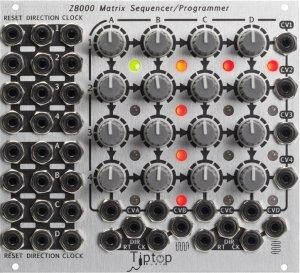
The Make Noise René (US$500) is a combination of a sequencer and performance controller, with a built-in touch keyboard that allows "playing" it as well as using the automatic sequencing. The touch keyboard (based on skin conductivity, not capacitive sensing) is something of a bugaboo for this module - it doesn't always respond well, and some people find they need to moisten their fingertips to get it to respond at all. But the module remains one of the most popular sequencers on ModularGrid.
Moving more in the direction of planned composition, Orthogonal Devices out of Japan offers the ER-101 sequencer and the ER-102 expander (US$600 and $450 respectively), which offer extensive control and editing of stored sequences in memory, through a unique interface based on rotary encoders and multiple seven-segment displays. This pair of modules is somewhat polarizing - people either like it or hate it - but it's probably the most sophisticated in-rack sequencing available without bringing in a full-blown general-purpose computer.
Random and automatic sequencing
It's a standard patch, something of a cliche, to run a noise source into a sample and hold module to generate a stream of random notes. The result is something like a step sequencer output with no fixed pattern to the melody. If you want a little more structure to your music but still something basically random at heart, there's the Turing Machine (about US$120 for a do-it-yourself kit). It's essentially a trigger sequencer that randomly changes its pattern over time. This one is not normally available as a finished module, though you may be able to find someone to build one for you if you don't want to build it yourself. "Expanders" for the Turing Machine allow it to also generate pitch control voltages and support other added features.
The Klee sequencer (pronounced like "clay," for the painter) is another take on automatic sequence generation, something like a cross between the Turing Machine and a basic modular step sequencer. It looks a lot like an A-155 with rows of LEDs and knobs, but instead of going through the steps one at a time, the Klee can turn on several steps at once, and the whole pattern shifts and changes with the clock. The voltages for the active steps are added up to generate the output. This is another one primarily available as a do-it-yourself project, and I'm not sure whether anyone is currently offering kits, so it may require a bit more effort and research to build your own.
Sometimes people just want to plug in a module and get useful sequences without a lot of programming, and there are modules designed for that. The term "Euclidean sequencing" in modular synthesis refers to a way of generating beat patterns that is not closely connected to the work of Euclid at all, but never mind, we're stuck with it. Enough of the patterns generated sound musical that there's value in a module specifically to generate them. The Rebel Technology Stoicheia (US$225) is a good example - you can just plug in a clock, set the knobs to the sequence length and density you want, and get a reasonable drum pattern. The Mutable Instruments Grids (US$230) is a somewhat more complicated module in a similar vein: it's like a wavetable for rhythm, with a bank of preset drum patterns and control voltage inputs to move between them.
Sequencing via computer
Although many wigglers try to avoid connecting a separate computer to the synth, it's really the most efficient way to play preplanned compositions. With a simple MIDI interface module like the Doepfer A-190-3 (US$140) or a more complicated one like the Mutable Instruments Yarns (US$360), you can put your modular synth under control of a software sequencer like those I listed in my rundown last November. If your taste runs more in the direction of DAW software like Ableton, Expert Sleepers has a whole series of modules with associated software plugins for interfacing between the DAW and the rack.
Something I'd like to see more of in the modular world is the use of custom-written software to do automatic sequence generation through MIDI. For example, here's one of my semi-automated compositions generated by homemade software sending notes to the modular as I adjust the knobs and do some repatching.
There's a lot further that sort of thing could be taken.
Continue to Part 13 of this series.
◀ PREV Alternate harmony with additive synthesis || Behind the scenes NEXT ▶
